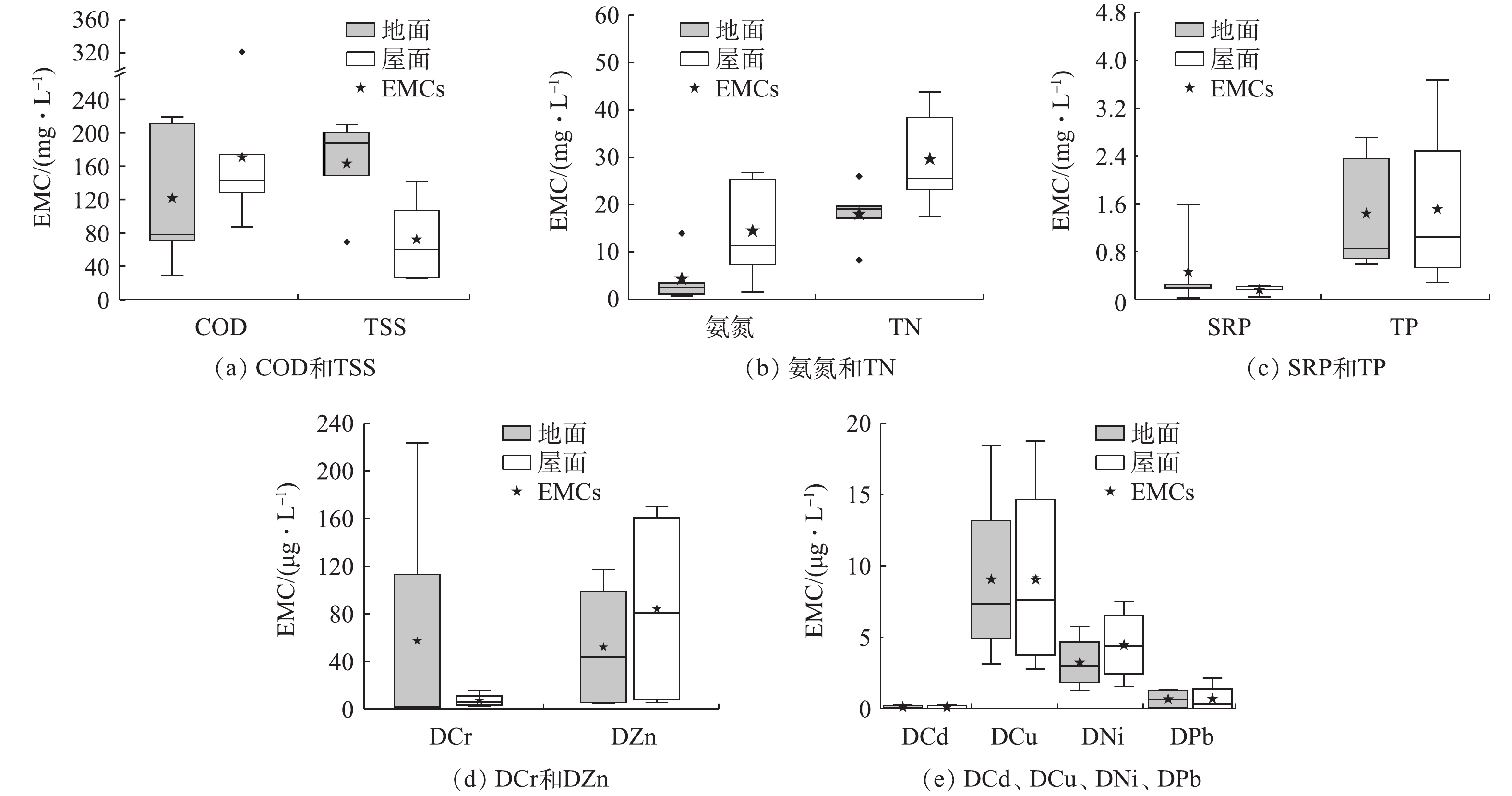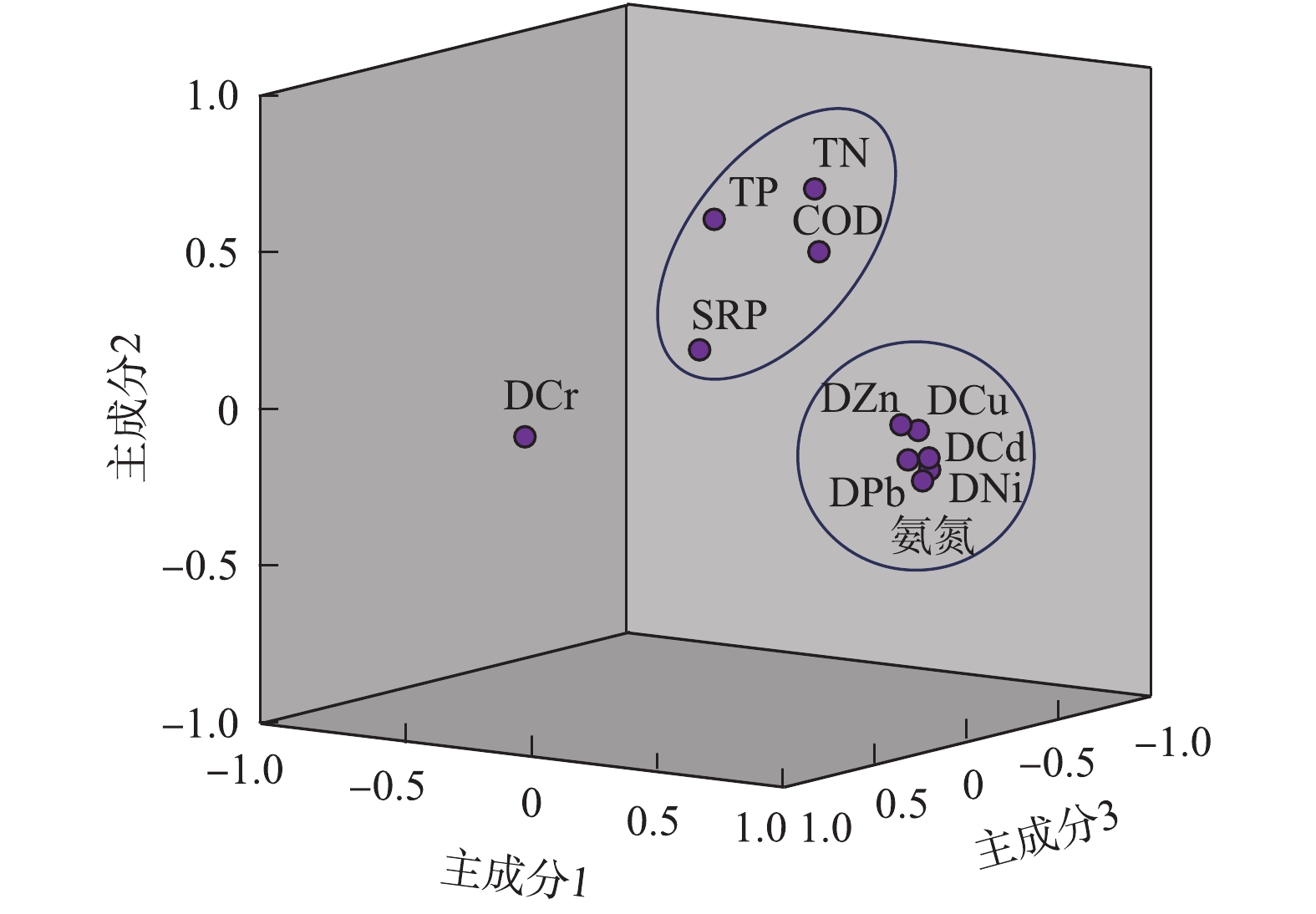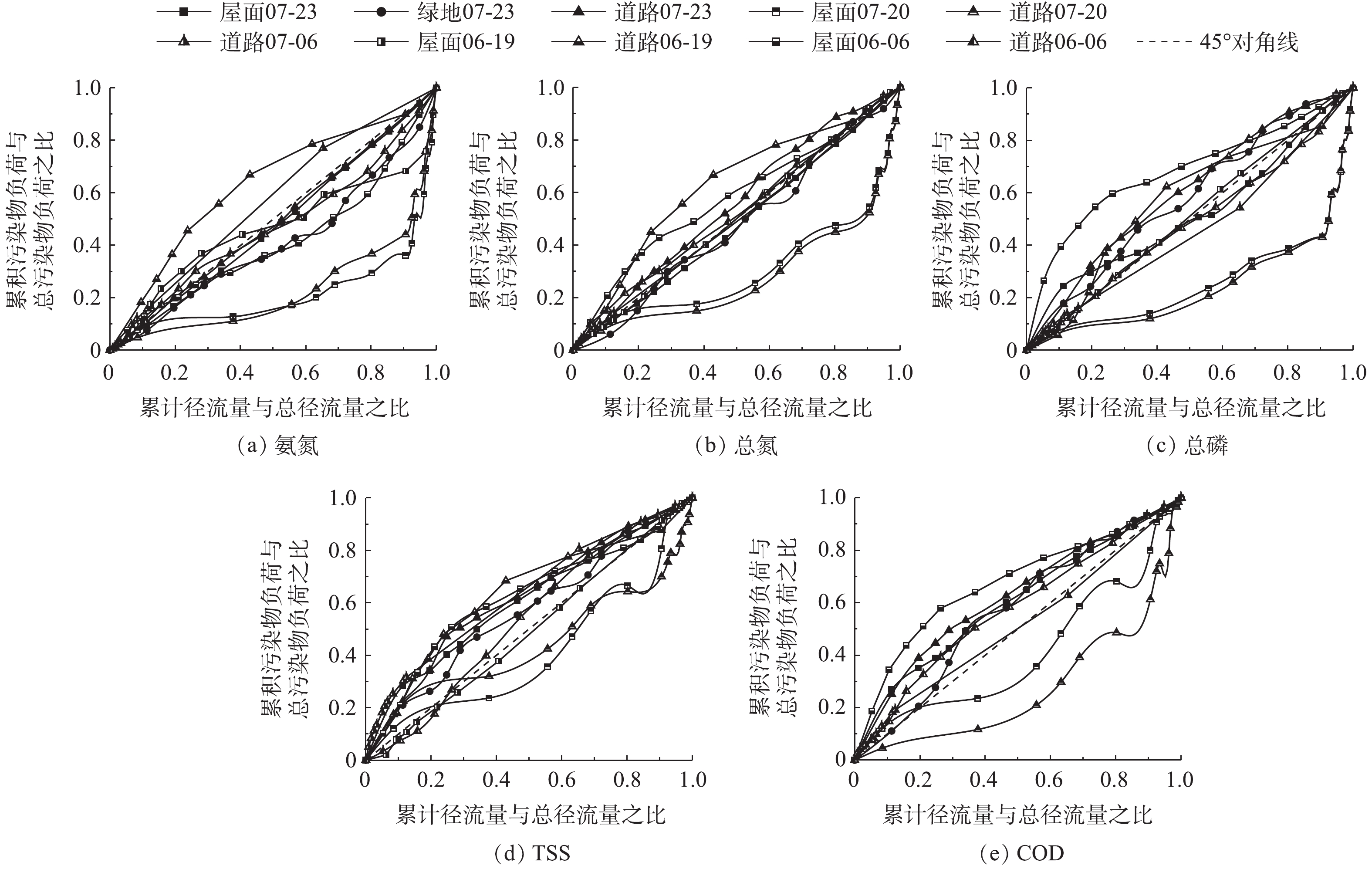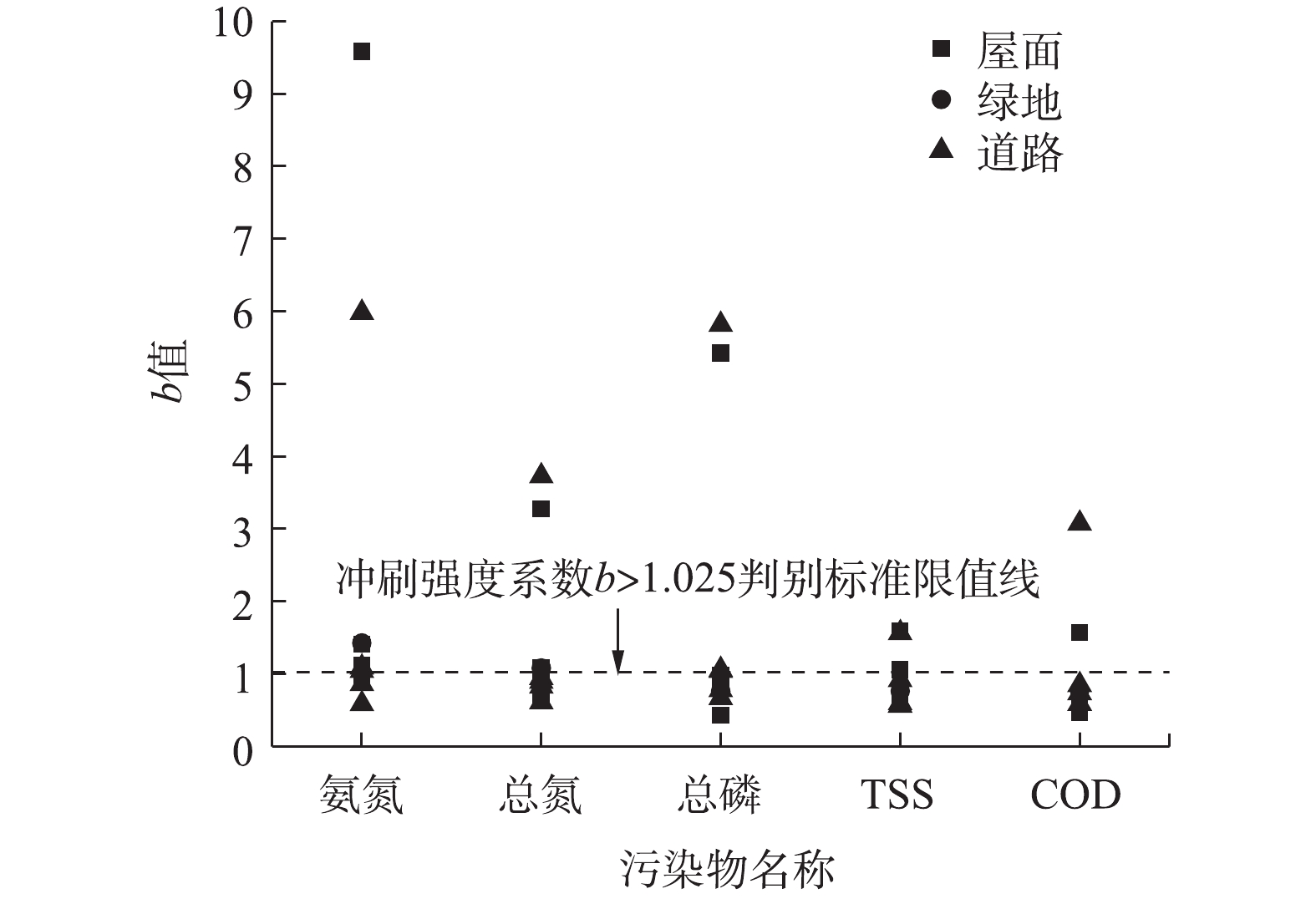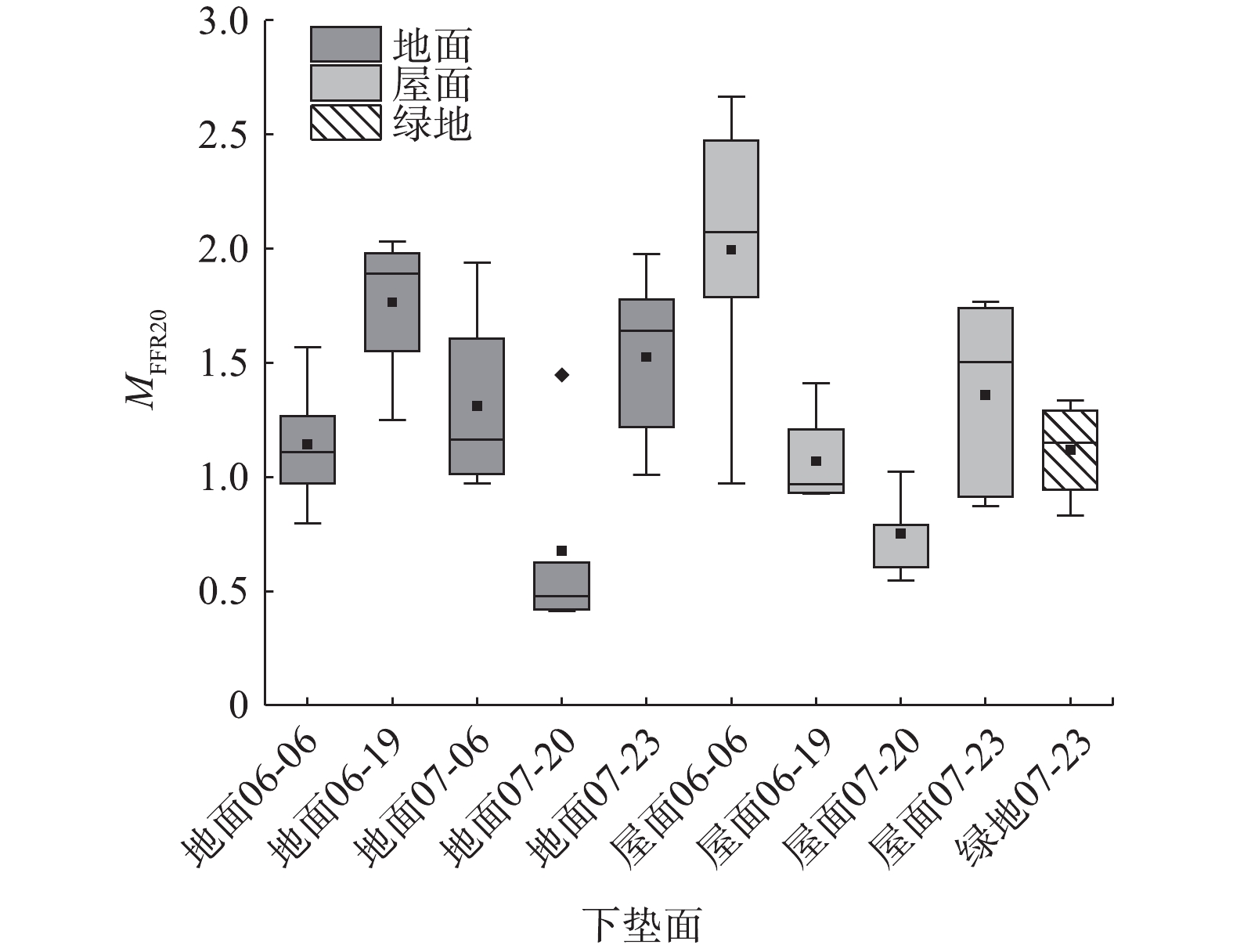-
随着点源污染问题的逐步解决和海绵城市建设的兴起,工业园区面源污染治理日益成为维持天津滨海新区水域生态安全和保障周边海域生态健康的重要举措[1-5]。“高消耗、密集型、集约化”的工业园区往往由于生态结构简单、产业链短缺导致物质循环和能量流动受阻。工业粉尘弥散、车辆尾气排放、化工生产原料运输或储存不当及建筑材料有毒物质的析出均会导致污染物的产生和累积。据报道[6],工业园区径流污染中TP、COD和重金属的负荷量约是混合住宅区和商业区的3~6倍。
目前,沿天津滨海新区的渤海湾区域分布着以石油化工、煤化工、海洋化工为主的10大化工产业群,工业园区内污染物的广泛分布和持续性累积,可通过降雨溶淋及径流冲刷使之汇入周边水域,这种集中式暴发及漫流污染扩散的生态风险,严重阻碍了工业园区的可持续发展和渤海水域的生态安全。随着天津市“工业东移和企业进入园区”战略的实施及近年来工业产业的迅猛发展,经济增长与环境恶化的矛盾日益凸显[7],工业园区面源污染的危害日趋严重,缓解区域生态环境恶化,维持周边海域生态安全,已成为当前滨海新区生态环境修复的首要任务。
为此,本研究以天津滨海新区临港工业园区1期建设产业园区为研究对象,通过覆盖该区域丰水期典型的5场降雨,解析其典型工业园区的水质污染特征,掌握工业园区径流污染状况;通过降雨径流污染源解析,探索径流污染源头控制的切入点;通过分析典型暴雨径流事件中污染物质量负荷与径流流量在不同下垫面中出现的初始冲刷现象,探究其工业园区径流污染输移规律,以期为当前工业园区面源污染控制和水环境质量提升,建设绿色生态工业园区提供参考。
-
天津滨海新区临港工业园区1期建设产业园位于天津市滨海新区东部,如图1所示,东临渤海,北接大沽沙航道;因处海陆交汇的核心地带,水汽交换活跃,降雨呈现夏多冬少,夜多昼少[8]。该工业园区1期建设面积约为18.3 km2,该园区凭借天津化工产业的雄厚基础,发展以石油化工、煤化工、海洋化工为主的高能耗化学产业,是当前天津市滨海新区10大工业园区的典型代表。目前,该园区工业废水及部分生活污水主要通过胜科污水处理厂以一级A排放标准统一处理,降雨径流雨水借助地势或排水管网及雨水提升泵站送入环形河道,经过临港绿色生态园的初步处理后,通过分布于西北部的1号排海泵站和东部的2号排海泵站将其径流雨水排入渤海湾。该区域主要包括屋面、道路、绿地3种典型的下垫面,三者面积之比约为8.28∶71.05∶20.67,其不透水面积约占据总面积(18.3 km2)的80%。
-
兼顾不同产业类型及土地利用类型的空间分布和所占比重,并且考虑到安全易行的操作原则,在研究区域内布设了11处采样点位。如图1所示,研究区域包括屋面径流雨水3处(包含不同倾斜程度的水泥屋面及厂房屋面)、地面径流雨水5处(在工业厂区庭院内和沥青混凝土等主要交通要道布设)、绿地径流雨水3处(布设于相应屋面及地面采样点附近的绿化带处)。同时由布置于该研究区域1号排海泵站和2号雨水泵站的2台超长待机雨量记录仪(美国DAVIS6463翻斗式雨量计,测量精度为±0.2 mm,分辨率为0.1 mm)实时监测该区域丰水季6—8月的降雨量。
本研究统一使用规格为500 mL的聚乙烯广口采样瓶,以保证在相应采样时段内尽可能采集到较多的混合雨水样。考虑到样品数量对降雨事件平均浓度(event mean concentration, EMC)估算结果的影响[9]及普遍的降雨径流污染物输移特性,并结合实际观测产流特征,确定了前密后疏的采样间隔时间。为连续采集次降雨径流雨水,将采样过程分为4个阶段:前10 min内为每2 min采集一瓶;在10~30 min内每5 min采集一瓶;在30~60 min内每10 min采集一瓶;在60~90 min内每15 min采集一瓶。实验最多可连续采集到14瓶雨水样。超过90 min的降雨场次需在降雨径流停止后采集各泵站的的混合雨水样,以校核次降雨径流污染总体水平。表1为典型降雨事件基本降雨特征。屋面径流雨水与地面径流雨水在每次降雨事件中每个点位采集到的样品数量一致,绿地径流雨水只有在2019年7月23日的次降雨事件中采集到。
样品采集完毕后,立即将置于车载冰箱中的样品迅速运回实验室。目前,导致渤海湾水质恶化的突出污染物质是COD、氮、磷和重金属,并发现陆源污染物的持续输入是导致水质恶化的主要原因[10-11],因此,水样分析指标优先关注COD、氮、磷和毒性重金属(Cu、Pb、Zn、Cr、Cd、Ni)。各指标的分析方法如表2所示。
-
1)径流污染负荷(EMCs)核算。由于降雨径流污染物排放的随机性,具体表现为降雨径流污染物输出的随机性或不同场次降雨径流的平均浓度EMC的随机性。美国国家环保署(USEPA)根据不同降雨事件EMC含量服从对数正态分布的特性,提出以多次降雨事件污染物的平均浓度EMCs作为衡量其径流污染的总体水平。本研究利用临港工业园区2019年6—8月采集到的5场典型降雨事件污染物的平均浓度(EMCs),阐述该区域丰水期降雨径流污染的总体水平。根据分别位于西北角和东南部的2台超长待机雨量记录仪实时监测的降雨数据,表明该研究区域范围内每场降雨特征无明显的空间异质性,故可根据《室外排水设计规范》,采用固定径流系数法计算径流量,单位采样时段内平均径流量
ˉQ(ti) 可根据式(1)计算。式中:
ˉi (ti )为单位采样时段内的平均降雨强度,mm·min−1,可通过全自动雨量计筛选出;ψ 为该区域的不同下垫面径流系数;F为下垫面面积,m2。通过计算不同空间位置的同一类型下垫面在相应采样时段内污染物的平均浓度ˉC(t) ,以此充分反映该区域次降雨事件径流污染的总体水平。次降雨事件的平均浓度根据式(2)进行计算。式中:CEMC为次降雨事件的平均浓度,mg·L−1;M为整个径流过程中污染物质量,mg;V为径流总量,L;t为时间,min;Qt为t时刻径流流量,L·min−1;Δt为采样间隔时间,min;tr是降雨径流持续时间,min。结合降雨事件代表性分析可知,5次降雨事件的平均浓度EMCs可大致反映该工业园区丰水期径流污染特征。
2)径流污染物M(V)输移曲线的构建及其解析。现已通过理论分析和实际观测证实了径流污染中初始冲刷现象的存在[12-13]。通常降雨强度越大,对下垫面的冲刷强度越大,污染物越有可能从下垫面转移到降雨径流中。在降雨强度和污染物总量相同的前提下,径流量越大,污染物浓度越低。因此,本研究采用M(V)曲线分析污染物质量与相应径流量之间的关系,以此判断降雨径流污染物输移特性,计算方法如式(3)和式(4)所示。通过污染物初始冲刷比率(first flush ratio,MFFRn)和冲刷强度系数b来全面地定量分析研究区域出现的初始冲刷效应。
式中:M(t)为降雨t时刻累积污染物负荷与总污染物负荷之比;V(t)为降雨t时刻累计径流量与总径流量之比;Q(t)为t时刻的瞬时流量,L·min−1;C(t)为t时刻的瞬时污染物浓度,mg·L−1;T表示降雨径流开始到结束的时间,min;Δt为时间增量,min;
ˉQ(ti) 在Δt时间的平均径流量,L·min−1。为确定初始冲刷效应发生的时间,MA等[14]根据M(V)累积曲线提出了初始冲刷比率(MFFRn)的计算方法。MFFRn阐释了累积径流量占总径流量的n%时,累计污染负荷占总负荷的比率与累积径流量占总径流量的比率之比。当MFFRn>1.0时,曲线位于45°平分线以上,表明出现初始冲刷现象。n为产流时刻到t时刻累积径流量占总径流量的百分比,取值为0~100,计算方法如式(5)所示。
若MFFR30≈2.66,则表示80%的径流污染质量通过30%的径流量冲刷携带出;MFFRn>1.0为初始冲刷效应发生的判别条件,该值越大,则冲刷现象越明显。
为定量分析初始冲刷强度,有研究[15]证明了累计污染负荷占总负荷的比率与累积径流量占总径流量的比率之间存在幂函数关系,计算方法如式(6)所示。
式中:M和V分别为累积污染负荷占比和累积径流量占比,取值均为0~1;b为冲刷强度指数。根据污染物曲线与45°对角线的偏差,可以反映径流污染在整个降雨过程中的冲刷强度,b值越小,表明初始冲刷强度越大,通常定义b>1.025为径流污染物输出过程属于稀释状态。
-
根据天津市滨海新区塘沽站年降雨量(1981—2010年)的分布特征可知,6—8月是天津市滨海新区全年降雨发生的主要时段,其累积降雨量约占全年的70%。如图2所示,5次降雨采集时间完全分布于降雨高发期,根据现场布置的全自动雨量计可知,除2019年8月2日降雨外,整个8月份未出现满足采集条件的降雨。由采集的次降雨强度和晴天累积时间分析可知:2019年7月23日的晴天累积时间虽然较短(间隔时间仅为2 d),但其平均降雨强度最大且为2019年7月20日平均降雨强度的10倍,2019年7月20日的降雨量虽与2019年6月6日大致相同,但由晴天累积时间来看,2019年7月6日至2019年7月20日共出现了3场降雨强度各异的降雨,且前2次降雨量(2019年7月13日和2019年7月7日)均高于2019年7月20日的降雨量。因此,无论是晴天累计时间还是次降雨强度或次降雨量,采集的5场降雨基本能够代表丰水期降雨径流的污染特征。
-
1)径流污染程度分析。由5次降雨径流事件污染物的平均浓度(EMCs)数据(图3)分析可知,整体上,COD的次降雨事件平均浓度(EMC)在地面和屋面径流雨水中均具有较大的变异性(图3(a))。但由EMCs数值分析结果可知,屋面径流雨水中COD含量较为突出,其EMCs含量高出地面径流雨水(EMCs=121.66 mg·L−1)的0.4倍;TP在道路径流雨水中EMCs值(EMCs=1.43 mg·L−1)与屋面径流雨水相当;而TSS(EMCs=72.12 mg·L−1)和SRP(EMCs=0.16 mg·L−1)含量在地面径流雨水中较为突出,分别为屋面径流雨水的1.26倍和1.87倍。道路径流雨水中悬浮物(TSS)质量浓度与再生水回用景观水体的水质标准(CJ/J 95-2000)相比,其EMCs值均超过标准限值(SS≤20 mg·L−1)的7.2倍。屋面径流雨水中氨氮和TN含量分别超出地面径流雨水的2.33倍和0.64倍,而屋面径流雨水中氨氮含量(EMCs=14.49 mg·L−1)占其总氮(EMCs=29.66 mg·L−1)的49%,远高于地面径流雨水中氨氮(EMCs=4.35 mg·L−1)所占总氮(EMCs=18.04 mg·L−1)比值的24%,这表明屋面径流雨水中氮含量较为突出且溶解性耗氧物质氨氮所占比例较大。从下垫面的面积来看,虽然屋面面积只占地面面积的11.6%,但其径流雨水中严重的水质污染依然不容小觑。究其原因,可能与下垫面相对较缓的坡度、锈蚀的表面及屋檐边广泛分布的排水围沟等因素有关,这些特征将直接影响着屋面对干沉降的的累积量。除此之外,屋面作为有效降雨、太阳辐射和气溶胶的“拦截器”,其屋面材料、老化程度、周边环境、暴雨持续时间和强度以及该地区高能耗产业尾气的昼夜排放等因素,均会导致高浓度径流雨水水质的产生。屋面材料的风化、干沉降的沉积、太阳辐射对潜在污染物的催化反应和分解加速是污染物产生的主要来源[16-17]。不可忽视的是,该研究区域相对较高的清洁卫生水平,是导致屋面径流雨水水质比地面径流雨水水质污染更加严重的重要因素。因此,环渤海湾分布的10大工业园区产生的高浓度径流污染可对天津滨海新区的可持续发展及及渤海湾水域的生态安全造成严峻的威胁。
由图3(d)和图3(e)可知,不同种类重金属含量差异较大,其EMCs含量大小依次为DZn>DCr>DCu>DNi>DPb>DCd,其中地面径流雨水中DCr含量较为突出,屋面径流雨水中以DZn元素含量较为突出,DCu、DPb、DCd、DNi在2种下垫面含量基本相同。
屋面径流中DZn(EMCs=84.12 μg·L−1)浓度是地面径流雨水(EMCs=52.18 μg·L−1)中的1.61倍,究其原因,可能是因为工业园区密布着含锌合金等屋面厂房[14]。与天津市主城区路面径流雨水重金属含量[18](EMCs(Cr)=77 μg·L−1、EMCs(Cu)=11 μg·L−1、EMCs(Cd)=10 μg·L−1)相比,除DCd在5场径流雨水中EMCs含量均低于主城区外,DCr和DCu的EMCs浓度含量在每场降雨事件中差异较大。地面径流雨水中DCr的EMCs含量与天津主城区路面径流雨水相当,但依然高于美国洛杉矶[19]EMCs(Cr)=10 μg·L−1,尤其是在地面径流雨水中,其EMCs(DCr)含量十分突出,约高出6.67倍。DCu在屋面和地面径流雨水中EMCs值均相当。有研究[20]表明,DCu的质量浓度超过10 μg·L−1时,对水体的自净能力会产生明显的抑制作用,超过4 μg·L−1时,会影响部分鱼类的生长繁殖;相对来说,DNi(EMCs(DNi)=3.64 μg·L−1)和DPb(EMCs(DPb)= 0.33 μg·L−1)含量在地表Ⅰ类水质量标准范围内(Ni≤20 μg·L−1,Pb≤10 μg·L−1)。可以看出,临港工业园区径流雨水中重金属污染相对较轻,与天津主城区相当,但比较突出的DCr、DZn、DCu 3种元素含量在临港工业园区地表径流中依然具有潜在的生态环境风险,其较强的生物有效性会通过食物链的富集作用危害到人类健康。
2)降雨径流污染来源解析。为了检验各污染物来源是否相同,通过SPSS 25.0进行了相关性分析,结果如表3所示。由表3可知,氨氮、DNi、DCu、DZn、DCd、DPb之间呈显著正相关(P≤0.01),其中DZn与DCu拟合系数最高,这表明6种溶解性水质指标可能有着共同的来源;氨氮与TN、TP、SRP无明显的相关性,这表明氨氮的来源与其他常规水质指标可能不同。DCr与其他10种污染物呈负相关,这表明DCr可能为单独来源。
结合主成分,对研究区域径流雨水中重金属来源进行了深入地解析,结果见图4。首先对全部数据进行了KMO检验和Barlett球形检验,结果显示,KMO值为0.779,Barlett球形检验值为1 110.348,且P<0,表明原数据适合主成分分析,基于特征值大于1,可识别出影响径流污染的3类污染源,且累积载荷平方和为72.525%。通过实际环境因子分析可知,在工业园区中,Ni、Cu、Zn、Cd、Pb、氨氮可能主要源自于与工业生产活动密切相关的交通运输和生产加工行业。根据JIRIES[21]和Al-KHASHMAN[22]的研究,Cu和Cd一方面可能来源于车辆的磨损,另一方面可能来源于工业生产加工等活动,合金材料和建筑材料的腐蚀、镀锌、塑料可能也是Cd、Cu、Zn、Ni、Pb等溶解性重金属的主要来源。据统计,在分布于该研究区域的61家工业企业中,从事与塑料加工有关的企业有5家,从事与机械生产装备的企业至少有3家,大型物流公司有2家。同时金属材料作为支撑工业园区厂房的主要介质,长期暴露于大气中,会不可避免地出现腐蚀现象,尤其是密度较小的锌合金材料经常被用来作为工业厂房,在屋面径流雨水中,Zn往往具有较高的排放浓度,这与水质分析中的结果相互印证。氨氮可能一方面来源于工业生产加工的废气排放,大气中氨氮可通过硫酸或硝酸结合反应生成(NH4)2SO4和NH4NO3,在降雨径流中形成水溶性二次污染物[23-24];另一方面可能与天然雨水中氨氮含量本身较高有关[25-26]。TP、TN、COD、SRP来源受生活源和自然源及工业源的共同影响,包括园区绿化的施肥、生活杂物的堆放、大气的干湿沉降等,但石油化工产业的贡献可能占主导地位;通过分析可知,DCr在地面径流雨水中含量较为突出,这可能主要与石油及煤化工生产特种设备制造有关,该工业园区至少分布着4家机械设备制造企业。
3)初始冲刷效应定量分析。通过降雨数据与径流污染物浓度数据,构建了径流污染物M(V)输移曲线(图5)。当曲线接近对角线时,说明径流初期污染物浓度变化不大,或说明污染负荷在整个径流中分布较为均匀。
各污染物曲线均有不同程度的波动。TN、TP、TSS、COD曲线上凸较为明显,说明降雨径流中TN、TP、TSS和COD均具有明显的初始冲刷效应,这与KIM等[27]和LEE等[28]对工业区等集水区的研究结果基本吻合。氨氮的M(V)曲线大多均与对角线齐平,且氨氮在径流中后期下凹较为明显,表明氨氮初始冲刷效应较弱。在前2次的降雨(2019年6月6日和2019年6月19日)径流污染物输出过程中,TN、TP、TSS、COD在道路上出现了强烈的初始冲刷效应,且在第2场降雨径流中(2019年6月19日)氨氮和TN均表现出显著的初始冲刷效应,但是在第4次降雨(2019年7月20日)径流雨水中,道路和屋面径流雨水明显出现被“稀释”的现象,这表明在次降雨事件中径流污染输出过程存在较大的变异性。
根据式(2)~式(5),计算得出各污染物MFFR20和MFFR30的冲刷程度指数,结果如图6所示。由总体趋势来看,污染物MFFR20和MFFR30指数的平均值除氨氮外均大于1,且TN、TP、TSS、COD的MFFR20指数平均聚集点高出MFFR30的10%;根据MFFRn定义可知,在降雨前20%的径流雨水中,TSS、TP、COD发生初始冲刷效应的概率较高。
根据式(2)~式(6),采用幂函数回归对各水质数据进行拟合,计算出初始冲刷系数b。拟合系数R2除个别值在0.80附近,87.5%的值均大于0.90,这说明拟合效果较好,满足初始冲刷强度分析。对不同污染物冲刷强度指数b的初始冲刷效果进行比较,结果如图7所示。可以看出,结果有75%的概率冲刷强度指数b<1.025,根据其定义,可知该研究区域径流雨水中污染物输移过程普遍趋于冲刷状态。
不同降雨事件中下垫面的初始冲刷比率MFFR20结果如图8所示。可以看出,道路和屋面径流雨水的初始冲刷效应在不同的降雨事件中均表现出较大的变异性,总体趋势呈现出不同步的状态。这可能是由于道路作为工业生产活动的重要载体,受到污染来源的随机性、降雨时间的不确定性和卫生清洁的不及时等多重因素的综合影响,这导致地面径流污染初始冲刷效应呈现出明显的波动状态。而屋面由于主要受到干沉降的积累,干扰因素相对较小,因而随着降雨场次的增加,屋面径流雨水的冲刷效应整体上呈现逐渐减弱的态势。值得注意的是,2019年7月23日的降雨作为丰水期间最大的一场强降雨,导致屋面和道路的径流污染初始冲刷效应均有所抬升,这也表明降雨强度对径流污染的冲刷效果是显著的。从不同下垫面污染物指数b的冲刷强度比较结果(图9)也可以得出该结论。
2019年7月20日的降雨事件中初始冲刷效果均不显著,结果如图9所示。究其原因:可能受到降雨强度、累积污染负荷、晴天累积时间等因素的复合影响[29-31],在此次降雨事件前经历了3次降雨径流的逐步“冲刷-清洗”过程,导致下垫面的污染物累积负荷相对较低;加之此次降雨事件强度相对较小,导致降雨对下垫面的冲刷作用明显减弱。而在2019年7月23日的降雨事件中,尽管此时累积污染负荷可能更少,但由于降雨强度的明显增强,凭借作用于下垫面的冲击负荷,可将难以冲刷的污染物从表层“剥离”出,进而出现明显的初始冲刷效应。需注意的是,具有自然属性的绿地下垫面只有在2019年7月23日的强降雨事件中收集到完整的径流雨水,其较低的产流量及滞后的径流峰现时间使得绿地在储存雨水和滞留径流污染方面发挥着明显的作用。
-
1)通过对天津临港工业园区一期建设产业园的屋面、道路、绿地3种典型下垫面径流雨水的采集与分析可知,COD、氨氮、TN在屋面径流雨水中较为突出,分别是地面径流雨水中EMCs含量的1.4、3.33和1.64倍;地面径流雨水中SRP和TSS含量分别为屋面径流雨水的2.26倍和2.87倍,TP在屋面径流雨水和地面径流雨水中污染程度相当。在Cu、Pb、Zn、Ni、Cr、Cd等6种溶解性金属元素中,除Pb、Ni、Cd低于地表Ⅰ类水标准限值外,其余3种元素在临港工业园区中均有潜在的生态环境风险,呈规模分布的工业园区径流污染必然对渤海湾水质恶化造成不可估量的影响。
2)由降雨径流污染来源解析可知,污染物总量控制与工业生产方式及清洁程度有关,干沉降的积累及屋面厂房金属材料的析出是导致屋面径流污染的本质原因;工业原料的妥善处理、工艺生产方式的优化可从源头上减少污染物的排放。
3)采用M(V)曲线对径流污染负荷及径流量进行量化分析,发现工业园区径流污染物COD、TN、TP均发生了不同程度的初始冲刷效应,总体上屋面和地面无显著性差异,且累积径流量的前20%能发生较为显著的初始冲刷效应,这表明初期雨水的收集处理可在一定程度上减缓工业园区径流污染,尤其是绿地在滞留雨水及促使污染物缓释方面发挥着重要作用。
天津滨海临港工业园区径流污染特征及其控制策略
Pollution characteristics and control strategies of runoff in Tianjin Binhai Lingang industrial park
-
摘要: 控制工业园区面源污染是解决天津滨海新区日益突出的水环境问题和维持周边海域水生态安全的关键。为缓解该区域日益突出的生态环境恶化与经济可持续发展的矛盾,以天津滨海新区临港工业园区1期建设产业园区丰水期的5场典型降雨径流为研究对象,通过多次降雨事件的平均浓度(EMCs)分析了工业园区不同下垫面的径流污染中氨氮(NH3-N)、总氮(TN)、活性磷(SRP)、总磷(TP)、化学需氧量(COD)、总悬浮物(TSS)及6种溶解性重金属铜(Cu)、铅(Pb)、锌(Zn)、铬(Cr)、镉(Cd)、镍(Ni)污染程度。结果表明,天津临港工业园区径流污染中COD、NH3-N、TN在屋面径流雨水中较为突出,COD(EMCs=170.68 mg·L−1)、氨氮(EMCs=14.49 mg·L−1)和TN(EMCs=29.66 mg·L−1)含量分别是地面径流雨水中EMCs含量的1.4、3.33和1.64倍;地面径流雨水中SRP(EMCs=1.87 mg·L−1)和TSS(EMCs=163.18 mg·L−1)含量分别为屋面径流雨水的2.26倍和2.87倍,TP含量(EMCs=1.43 mg·L−1)在屋面径流雨水和地面径流雨水中含量相当;6种毒性重金属污染程度相对较轻,与天津主城区相当,比较突出的Cr、Zn、Cu 3种元素含量在临港工业园区径流污染中依然具有潜在的生态环境风险。以径流污染输出负荷同径流量关系的M(V)曲线为基础,通过污染物初始冲刷比率(MFFRn)及冲刷强度系数b对不同下垫面径流污染物输移过程进行量化分析。结果表明,总体上,累积径流量的前20%能发生较为显著的初始冲刷效应(MFFR20比MFFR30高出10%),且出现初始冲刷现象(b<1.025)的概率约为75%,降雨强度及下垫面累积污染负荷会对次降雨径流污染输移曲线产生较大影响。结合污染物来源解析可知,源头控制、过程清洁及初期雨水截流是缓解当前工业园区径流污染的有效策略。Abstract: Controlling non-point source pollution in industrial parks is the key to solve the increasingly prominent water environment problems in Tianjin Binhai New Area and to maintain the water ecological security in the surrounding sea areas. In order to alleviate the increasingly prominent contradiction between the deterioration of ecological environment and sustainable economic development in the region, five typical rainfall runoffs during the flood season of Lingang Industrial Park Phase 1 construction in Tianjin Binhai New Area were taken as the research object in this study. The average concentrations of multiple rainfall events (EMCs) were used to analyze the pollution levels of Ammonia Nitrogen (NH3-N), Total Nitrogen (TN), Soluble Reactive Phosphorus (SRP), Total Phosphorus (TP), Chemical Oxygen Demand (COD), Total Suspended Solids (TSS) and six soluble heavy metals Cu, Pb, Zn, Cr, Cd, Ni in the runoff pollution of different underlying surfaces in the industrial park. The results showed that COD, NH3-N and TN in runoff pollution in Tianjin Lingang Industrial Park were more prominent in roof runoff rainwater, and the contents of COD (EMCs=170.68 mg·L−1), ammonia nitrogen (EMCs=14.49 mg·L−1) and TN (EMCs=29.66 mg·L−1) were 1.4, 3.33 and 1.64 times of those in surface runoff rainwater, respectively. The contents of SRP (EMCs=1.87 mg·L−1) and TSS (EMCs=163.18 mg·L−1) in surface runoff rainwater were 2.26 and 2.87 times of those in roof runoff rainwater, respectively, and the TP content (EMCs=1.43 mg·L−1) was equivalent between roof runoff rainwater and surface runoff rainwater. The pollution degree of six toxic heavy metals was relatively light, which was equivalent to the main urban area of Tianjin. The prominent contents of Cr, Zn and Cu still had potential ecological and environmental risks in runoff pollution in Lingang Industrial Park. Based on the M(V) curve of the relationship between runoff pollution output load and runoff, the pollutant transport process of runoff on different underlying surfaces was quantitatively analyzed through the pollutant first scour ratio (MFFRn) and scour intensity coefficient b. The results showed that, in general, the first 20% of accumulated runoff was more prone to the first scouring effect (MFFR20 is 10% higher than MFFR30) than the first 30% of accumulated runoff, and the probability of the first scouring phenomenon (b<1.025) was about 75%. Rainfall intensity and the accumulated pollution load on the underlying surface had a great impact on the pollution transport curve of the secondary rainfall runoff. Combined with the analysis of pollutant sources, source control, process cleaning and initial rainwater interception will be effective strategies to alleviate runoff pollution in the current industrial park.
-
Key words:
- stormwater runoff /
- industrial parks /
- first flush /
- source apportionment
-
表 1 典型降雨事件基本降雨特征
Table 1. Basic rainfall characteristics of typical rainfall events
降雨日期 降雨量/mm 降雨历时/h 平均降雨强度/(mm·h−1) 最大降雨强度/(mm·h−1) 2次降雨间隔时间/d 2019-06-06 3.6 3 0.9 1.2 1 2019-06-19 4.6 2.5 1.84 2.0 3 2019-07-06 27.2 8 3.4 4.4 1 2019-07-20 3.8 4 0.95 2.8 6 2019-07-23 43.2 4.5 9.6 13.2 2 表 2 水样各指标监测分析方法
Table 2. Analytical methods for water quality parameters
监测指标 分析/测定方法 标准 氨氮 水杨酸分光光度法 HJ 536-2009 TN 碱性过硫酸钾消解紫外分光光度法 HJ 636-2012 TP/SRP 钼酸铵分光光度法 GB 11893-1989 COD 哈希试剂快速消解分光光度法 HJ/T 399-2007 TSS 重量法 GB 11901-1989 溶解性重金属 水质65种元素的测定电感耦合等离子体质谱仪 HJ 700-2014 表 3 降雨径流中监测污染物指标相关性分析
Table 3. Correlation analysis of monitoring pollutant indices in rainfall runoff
项目 COD 氨氮 TN TP SRP DCr DNi DCu DZn DCd DPb COD 1 氨氮 0.211* 1 TN 0.272** 0.11 1 TP 0.345** 0.023 0.234* 1 SRP 0.260** 0.114 −0.012 0.063 1 DCr −0.103 −0.271** −0.220* 0.1 0.019 1 DNi 0.457** 0.685** 0.029 0.104 0.094 −0.187* 1 DCu 0.433** 0.569** 0.075 0.204* 0.134 −0.182 0.831** 1 DZn 0.398** 0.603** 0.06 0.299** 0.194* −0.105 0.755** 0.924** 1 DCd 0.374** 0.815** 0.013 0.103 0.109 −0.091 0.888** 0.770** 0.773** 1 DPb 0.408** 0.683** 0.009 0.194* 0.186* −0.048 0.836** 0.908** 0.929** 0.902** 1 注:**为P<0.01,相关性显著;*为P<0.05,相关性显著。 -
[1] 张志彬, 孟庆宇, 马征. 城市面源污染的污染特征研究[J]. 给水排水, 2016, 42(1): 163-167. [2] 赵琰鑫, 彭虹, 王双玲, 等. 分布式工业区面源污染模型研究[J]. 武汉大学学报(工学版), 2012, 45(5): 594-597. [3] 吴丹洁, 詹圣泽, 李友华, 等. 中国特色海绵城市的新兴趋势与实践研究[J]. 中国软科学, 2016(1): 79-97. doi: 10.3969/j.issn.1002-9753.2016.01.008 [4] 姜德娟. 关于加强面源污染治理的建议[J]. 中国发展, 2016, 16(1): 88-89. doi: 10.3969/j.issn.1671-2404.2016.01.017 [5] 刘娟. 渤海化学污染物入海通量研究[D]. 青岛: 中国海洋大学, 2006. [6] BOARD T. Urban stormwater management in the United States[R]. Washington D C: The National Academies Press, 2008. [7] 王松, 唐运平, 余海晨, 等. 天津滨海新区工业园区水环境问题概述[J]. 广东化工, 2011(12): 97-98. [8] 熊明明, 徐姝, 李明财, 等. 天津地区小时降水特征分析[J]. 暴雨灾害, 2016, 35(1): 84-90. doi: 10.3969/j.issn.1004-9045.2016.01.012 [9] 陈莹, 王昭, 赵剑强, 等. 样品数量对径流事件平均浓度估算结果的影响: 以时间间隔采样法为例[J]. 中国环境科学, 2017, 37(2): 620-627. [10] 郑丙辉, 秦延文, 孟伟, 等. 1985~2003年渤海湾水质氮磷生源要素的历史演变趋势分析[J]. 环境科学, 2007, 28(3): 48-53. [11] 陈秀, 李爽兆, 袁德奎, 等. 渤海湾沉积物重金属的分布特征及影响因素[J]. 海洋科学进展, 2017, 35(3): 382-391. doi: 10.3969/j.issn.1671-6647.2017.03.008 [12] 车伍, 张炜, 李俊奇, 等. 城市雨水径流污染的初期弃流控制[J]. 中国给水排水, 2007, 23(6): 1-5. [13] GUPTA K, SAUI A J. Specific relationships for the first flush load in combined sewer flows[J]. Water Research, 1996, 30(5): 1244-1252. doi: 10.1016/0043-1354(95)00282-0 [14] MA Z B, NI H G, ZENG H, et al. Function formula for first flush analysis in mixed watersheds: A comparison of power and polynomial methods[J]. Journal of Hydrology (Amsterdam), 2011, 402(3/4): 333-339. [15] BERTRAND-KRAJEWSKI J L, CHEBBO G, SAGET A. Distribution of pollutant mass vs volume in stormwater discharges and the first flush phenomenon[J]. Water Research, 1998, 32(8): 2341-2356. doi: 10.1016/S0043-1354(97)00420-X [16] CHANG M, CROWLEY C M. Preliminary observations on water quality of storm runoff from four selected residential roofs[J]. Jawra Journal of the American Water Resources Association, 2010, 29(5): 777-783. [17] CHANG M, MCBROOM M W, BEASLEY R S. Roofing as a source of nonpoint water pollution[J]. Journal of Environmental Management, 2004, 73(4): 307-315. doi: 10.1016/j.jenvman.2004.06.014 [18] 李倩倩, 李铁龙, 赵倩倩, 等. 天津市路面径流雨水径流重金属污染特征[J]. 生态环境学报, 2011, 20(1): 143-148. doi: 10.3969/j.issn.1674-5906.2011.01.025 [19] LEGRET M, PAGOTTO C. Evaluation of pollutant loadings in the runoff waters from a major rural highway[J]. Science of the Total Environment, 1999, 235: 143-150. doi: 10.1016/S0048-9697(99)00207-7 [20] 孙思杨. 铜、锌的水质标准及水质对水生物的生态安全影响[D]. 南昌: 南昌大学, 2016. [21] JIRIES A. Chemical composition of dew in Amman, Jordan[J]. Atmospheric Research, 2001, 57: 261-268. doi: 10.1016/S0169-8095(01)00079-5 [22] Al-KHASHMAN O A. The investigation of metal concentrations in street dust samples in Aqaba city, Jordan[J]. Environmental Geochemistry and Health, 2007, 29(3): 197-207. doi: 10.1007/s10653-006-9065-x [23] 葛顺, 汤莉莉, 秦玮, 等. 南京地区秋季灰霾天气特征及其水溶性离子分析[J]. 环境科学与技术, 2015, 38(2): 99-104. [24] 杨凌霄, 侯鲁健, 吕波, 等. 济南市大气细颗粒物水溶性组分及大气传输的研究[J]. 山东大学学报(工学版), 2007, 34(4): 98-103. doi: 10.3969/j.issn.1672-3961.2007.04.021 [25] 张静, 周玉文, 王中正, 等. 北方城市天然降雨中氨氮污染特征研究[J]. 环境科学与技术, 2016, 39(6): 129-134. [26] 刘大喜, 李倩倩, 李铁龙, 等. 北方沿海城市屋面雨水径流水质及影响因素[J]. 环境科学与技术, 2016, 39(12): 100-105. [27] KIM G, YUR J, KIM J. Diffuse pollution loading from urban stormwater runoff in Daejeon city, Korea[J]. Journal of Environmental Management, 2007, 85(1): 9-16. doi: 10.1016/j.jenvman.2006.07.009 [28] LEE J H, BANG K W, KETCHUM L H, et al. First flush analysis of urban storm runoff[J]. Science of the Total Environment, 2002, 293(1/2/3): 163-175. [29] 张香丽, 赵志杰, 秦华鹏, 等. 常州市不同下垫面污染物冲刷特征[J]. 北京大学学报(自然科学版), 2018, 54(3): 645-654. [30] 任玉芬, 王效科, 欧阳志云, 等. 北京城市典型下垫面降雨径流污染初始冲刷效应分析[J]. 环境科学, 2013, 34(1): 373-378. [31] 李立青, 尹澄清, 孔玲莉, 等. 2次降雨间隔时间对城市地表径流污染负荷的影响[J]. 环境科学, 2007, 28(10): 137-143. -






 下载:
下载:

